Click on images to enlarge
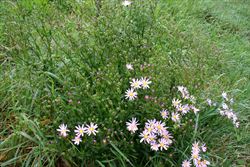
habit (Photo: Trevor James)

habit prior to flowering (Photo: Trevor James)

habit in flower (Photo: Trevor James)
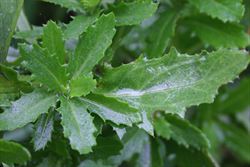
leaves (Photo: Trevor James)

leaves with deeply-toothed margins (Photo: Trevor James)
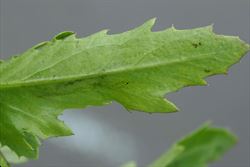
close-up of leaf underside (Photo: Trevor James)
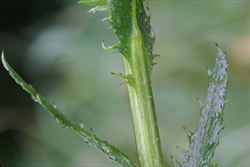
close-up of stem and upper leaves (Photo: Trevor James)
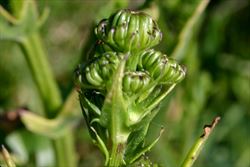
close-up of young flower-heads (Photo: Trevor James)

close-up of flower-head from side-on, showing the floral bracts (Photo: Trevor James)
Scientific Name
Senecio glastifolius L. f.Family
Asteraceae (Queensland, New South Wales, the ACT, Victoria, Tasmania, Western Australia and the Northern Territory)Compositae (South Australia)
Common Names
holly leaf senecio, holly leaved senecio, holly-leaf senecio, holly-leafed senecio, holly-leaved senecio, large senecio, pink ragwort, purple African daisy
Origin
Native to southern Africa (i.e. Cape Province in South Africa).
Cultivation
Holly-leaved senecio (Senecio glastifolius) has occasionally been cultivated as a garden ornamental in Australia.
Naturalised Distribution
Locally naturalised in the coastal districts of south-western Western Australia, particularly near Albany, and occasionally naturalised in the coastal districts of central New South Wales.
Also widely naturalised in New Zealand.
Habitat
In South Africa it grows naturally in shrubland and near waterways (i.e. in riparian vegetation). It grows in similar habitats here in Australia, as well as in open woodlands, on hillsides, in coastal dunes, along roadsides and in disturbed sites.
Habit
An upright (i.e. erect) and either short-lived (i.e. annual) or long-lived (i.e. perennial) herbaceous plant usually growing 1-1.5 tall, but occasionally reaching up to 2 m in height.
Distinguishing Features
- an upright and short-lived, or more commonly long-lived, herbaceous plant growing up to 2 m tall.
- its much-branched stems are mostly hairless with fine ridges running lengthwise.
- its stem-clasping leaves (3-15 cm long) have sharply-toothed margins and resemble holly leaves.
- its daisy-like flower-heads have 12-22 pink or purple 'petals' surrounding a yellow centre.
- its brown 'seeds' (2-2.5 mm long) are initially topped by a ring of whitish hairs 7-9 mm long.
Stems and Leaves
The much-branched stems are mostly hairless (i.e. glabrous) with fine ridges running lengthwise (i.e. they are striate).
The alternately arranged leaves are stalkless (i.e. sessile) and hairless (i.e. glabrous) and those near the base of the plant are somewhat larger than those at the tops of the branches. These leaves (3-15 cm long) are egg-shaped (i.e. ovate) to oval (i.e. elliptic) in outline, but are sharply-toothed (i.e. serrate) and have pointed tips (i.e. acute apices). Their bases are stem-clasping and extend slightly down the stem (i.e. they are decurrent).
Flowers and Fruit
The daisy-like flower-heads are usually borne in dense flat-topped clusters at the tips of the branches. Each flower-head has 12-22 pink or purple 'petals' (i.e. ray florets) that are 12-25 mm long. These surround a yellow centre made up of numerous tiny tubular flowers (i.e. tubular or disc florets), and are surrounded at the base by a ring of 19-23 greenish-coloured bracts (i.e. involucral bracts) 6-9 mm long. Flowering occurs mostly during late spring.
The brown 'seeds' (i.e. achenes or cypselas) are 2-2.5 mm long and are topped by a ring of whitish hairs (i.e. pappus) 7-9 mm long. However, these hairs readily become detached from the 'seeds', which are produced during summer and early autumn.
Reproduction and Dispersal
Holly-leaved senecio (Senecio glastifolius) reproduces mainly by seed, but can also spread vegetatively from fallen branches that readily take root.
The seeds are primarily wind-dispersed, but the slashing of fire breaks in infested areas and the movement of contaminated soil are also thought to assist the spread of this species.
Environmental Impact
Holly-leaved senecio (Senecio glastifolius) is regarded as an environmental weed in New South Wales and Western Australia, and as a potential environmental weed or "sleeper weed" in other parts of southern Australia (i.e. Victoria, South Australia and Tasmania). It is also on the Alert List for Environmental Weeds, a list of 28 non-native plants that are only in the early stages of establishment but have the potential to threaten biodiversity and seriously degrade Australia's ecosystems.
Legislation
This species is declared under legislation in the following states and territories:
- Tasmania: D - the importation or sale of this species is prohibited and measures to reduce its population in an area, eradicate it from an area, or restrict it to a particular area may be required.
- Western Australia: Prohibited - on the prohibited species list and not permitted entry into the state.
Similar Species
Holly-leaved senecio (Senecio glastifolius) is relatively similar to purple groundsel (Senecio elegans). These two species can be distinguished from each other by the following differences:
- holly-leaved senecio (Senecio glastifolius ) is usually a relatively large long-lived (i.e. perennial) herbaceous plant growing 1-1.5 tall. It leaves have sharply-toothed margins and its flower-heads have 12-22 pink or purple 'petals' (12-25 mm long).
- purple groundsel (Senecio elegans) is a relatively small short-lived (i.e. annual) herbaceous plant growing 0.3-1 m tall. Its leaves have bluntly-toothed or sharply-toothed margins and its flower-heads have 12-15 pink or purple 'petals' (15-20 mm long).
This fact sheet has been updated thanks to the sponsorship of Sunshine Coast Council.

